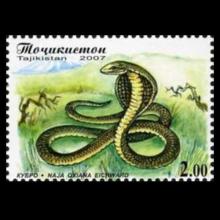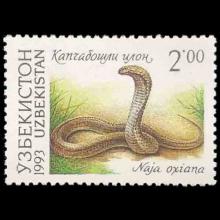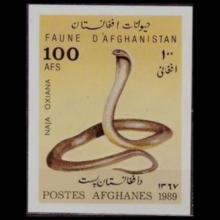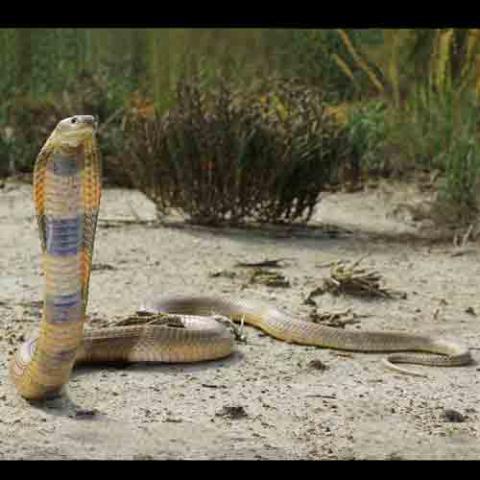NAMES
TAXONOMY
Tajikistan
Issued:
Stamp:
Naja oxiana
Uzbekistan
Issued:
Stamp:
Naja oxiana
Afghanistan
Issued:
Stamp:
Naja oxiana
Tajikistan
Issued:
Stamp:
Naja oxiana
Uzbekistan
Issued:
Stamp:
Naja oxiana
Afghanistan
Issued:
Stamp:
Naja oxiana
Tajikistan
Issued:
Stamp:
Naja oxiana
Uzbekistan
Issued:
Stamp:
Naja oxiana
Afghanistan
Issued:
Stamp:
Naja oxiana
Not sure what the precise genus species is of the cobra snake in this video. Nevertheless, it is a fascinating look into the world of snake charmers.
Genus species (Animalia): Naja oxiana
Naja oxiana is medium in length, a heavy-bodied snake with long cervical ribs capable of expansion to form a hood. Anteriorly, the body is depressed dorsoventrally, and posteriorly it is subcylindrical. This species averages about 1 m (3.3 ft) in total length (including tail) and rarely reaches lengths over 1.5 m (4.9 ft). The head is elliptical, depressed, and slightly distinct from the neck, with a short, rounded snout and large nostrils. The eye is medium in size with a round pupil. The dorsal scales are smooth and strongly oblique, with the outer two or three scale rows larger than the remainder. Juveniles tend to be pale, with a faded appearance. Juveniles have noticeable dark and light cross-bands of approximately equal width around the body. Adults of this species are completely light to chocolate brown or yellowish, with some specimens retaining traces of juvenile banding, especially the first few dark ventral bands. This species has no hood mark and no lateral throat spots.
Taxonomic note
Indian cobra (Naja naja) specimens without a hood mark are usually confused with this species, where these two coexist in Pakistan and northern India. The Caspian cobra (Naja oxiana) is never fully black, although some specimens may be quite dark. The Caspian cobra (N. oxiana) normally has several dark bands under the throat, whereas in the black phase of the Indian cobra (N. naja) from Pakistan, almost the entire throat is black.
Scalation
Naja oxiana has 23 to 27 (usually 25) dorsal scale rows at the hood, 19-23 (usually 21) just ahead of midbody, 191-210 ventrals, and 57-71 paired subcaudals; cuneates (small angular scales between the labials) are often absent.
Distribution
N. oxiana occurs in the Transcaspian region. It is found in Turkmenistan, Uzbekistan, Kyrgyzstan, Tajikistan, north and east Afghanistan, northeastern Iran, the northern half of Pakistan, from the Kashmir region east to the state of Himachal Pradesh in India, and in southwestern Tajikistan. There is also some anecdotal evidence of it ranging as far north as the Aral Sea on the Uzbekistan/Kazakhstan border.
Habitat
N. oxiana is often found in arid and semiarid, rocky or stony, shrub or scrub covered foothills at elevations up to about 3,000 m (9,800 ft) above sea level. This is also the westernmost species of Asiatic cobra.
Behavior and ecology
N. oxiana is generally aggressive and bad-tempered. Although it will avoid humans as much as it can, it will become fiercely aggressive when threatened or cornered. Even juveniles tend to be very aggressive. When cornered and provoked, it will spread its hood, hiss, sway from side to side and strike repeatedly; it is not a spitter. This terrestrial species is mainly diurnal, but it may be crepuscular and nocturnal in some parts of its range during the hottest months (July and August). It is a good climber and a good swimmer. It is often found in water and seldom found too far away from it. It feeds on small mammals, amphibians, and birds during the evening and early morning. The Caspian cobra will prey mainly on rodents, toads and frogs, occasionally fish, and birds and their eggs. Quick-moving and agile, this species lives in holes in embankments or trees.
Venom
Composition
The Caspian cobra is the most venomous species of cobra in the world, slightly ahead of the Philippine cobra, based on a 1992 toxinological study reported in the Indian Journal of Experimental Biology. A number of small nonenzymatic proteins are found in the venom, including neurotoxins and members of the cytotoxin family, which have been shown to cause cell death through damage to lysosomes. In addition to nonenzymatic proteins, the venom also contains nucleases, which cause tissue damage at the site of the bite and may also potentiate systemic toxicity by releasing free purines in situ. A ribonuclease isolated and purified from Caspian cobra venom, ribonuclease V1, is commonly used as a laboratory reagent in molecular biology experiments due to its unusual ability to break down structured RNA.
Toxic effects
The crude venom of N. oxiana has a lowest published lethal dose (LCLo) of 0.005 mg/kg, the lowest among all cobra species, derived from an individual case of poisoning by intracerebroventricular injection. Values for subcutaneous injection average 0.18 mg/kg (range 0.1 mg/kg - 0.26 mg/kg). The murine subcutaneous LD50 value has been estimated between 0.21 mg/kg and 0.4 mg/kg. The intravenous injection route yielded estimates between 0.037 mg/kg and 0.078 mg/kg. Average venom yield per bite for this species is between 75 and 125 mg (dry weight), but can reach up to 590 mg.
The bite of this species may cause severe pain and swelling, along with severe neurotoxicity. Weakness, drowsiness, ataxia, hypotension, and paralysis of throat and limbs may appear in less than one hour after the bite. Without medical treatment, symptoms rapidly worsen and death can occur soon after a bite due to respiratory failure. A woman bitten by this species in northwestern Pakistan suffered severe neurotoxicity and died while en route to the closest hospital nearly 50 minutes after envenomation. Between 1979 and 1987, 136 confirmed bites were attributed to this species in the former Soviet Union. Of the 136, 121 received antivenom, and only 8 died. Of the 15 who did not receive antivenom, 11 died - a 73% mortality rate. Antivenom is not as effective for envenomation by this species as it is for other Asiatic cobras within the same region, like the Indian cobra (Naja naja), and massive amounts of antivenom are often required for patients. As a result, a monovalent antivenom serum is being developed by the Razi Serum and Vaccine Research Institute in Iran. The untreated mortality rate for this species is approximately 70-75%, which is among the highest of all cobra species of the genus Naja. In both Central Asia and Iran this species is responsible for high rates of snakebites and resulting mortality.
Reference: Wikipedia




